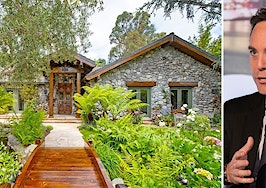There’s this thing that has become common in 2020 where people get on their phones or computers and just start scrolling through endless bad news. It’s weird and addictive — and it breeds anxiety — and it even has a name: doomscrolling.
But alongside the rise of doomscrolling this year, a curious anecdote has also taken shape: endlessly browsing real estate listings on Zillow.
The New York Times Taylor Lorenz recently dove into the proliferation of Zillow-scrolling in two different pieces, one of which is a new weekly column on Curbed about recreational Zillow usage. In the pieces, Lorenz explores how Zillow has become increasingly popular among unlikely groups like teenagers, and how her own use of the site has outpaced the time she spends on social networks like Instagram and TikTok. The gist here is that there seems to be something comforting, fun and maybe a bit aspirational about looking through endless real estate listings.
But the pieces also raise several existential questions: First, if people are increasingly using Zillow for entertainment, why doesn’t Zillow just lean into that behavior and add, for example, a comment section — which many users have been asking for since at least since 2014? In other words, why isn’t the platform more social?
And second, amid all this rising interest in Zillow, are the company’s customers — or, real estate agents — actually benefiting?
Inman reached out to Zillow to get answers.
The company didn’t directly say why it doesn’t have a more social site design, or why it specifically lacks a comments section. In a statement, a company spokesperson said that “we know home has never been more important than it is today.”
“That’s why our investments in technology and our partnerships with best-in-class agents make us well positioned to meet the needs of our customers — now and in the future,” the statement added.
A company source also told Inman in an email that Zillow loves that people enjoy browsing the site and that it has consequently invested in making a fun shopping experience.
“Shopping” seems to be the operative word there, and for the time being it appears Zillow is content to be a portal and lead generator (and now also a brokerage). Which is to say, Zillow is perhaps closer to Amazon, a shopping site, than Facebook, which is more about content.
Additionally, much of the discussion about Zillow also takes place on other platforms. In fact, there are multiple genres dedicated to Zillow on video sharing app TikTok. There’s even a hashtag, “ZillowIsTheNewTinder,” that jokingly compares the company to a dating app.
https://www.tiktok.com/@benbiswas/video/6877356673346850054?_d=secCgsIARCbDRgBIAIoARI%2BCjwXKkYqrG8t2pNqcHLRPrNTqgeXZoXUIJOjIPadgM9liaQ%2FuBpq3E3CQS0wmL8bdn%2FzWpU%2Bv7Q2VMLB4qgaAA%3D%3D&language=en&preview_pb=0&sec_user_id=MS4wLjABAAAAg8g_3wfd9bsUkN-37WhQ_HIPLcNfMwhPiKHsw-od-7XbX8EMw6fw9OBACyoM-nzD&share_item_id=6877356673346850054&share_link_id=C8672852-1CE5-4201-A600-E74156EEDDDC×tamp=1605895650&tt_from=copy&u_code=d3k6kh77432cji&user_id=6637558711932321797&utm_campaign=client_share&utm_medium=ios&utm_source=copy&source=h5_m
But these kinds of posts also shed light on a possible reason that Zillow hasn’t fully embraced social content; in many cases, users are turning to the site to “roast” houses. Much of this house-bashing is done for comedic effect, but if you’re in the business of actually selling the houses, or working with the people who do, it makes sense that you wouldn’t want sick burns next to listing photos.
@cyberexboyfriend #greenscreen Zillow roast 9/8 #OurType #interiordesign #zillowhouse #zillowisthenewtinder #blacktiktok #xyzabct
Moreover, goes without saying that Zillow’s paying customers — primarily members of the real estate industry who use the Premier Agent program to get leads — also probably wouldn’t love a lot of mean comments on the site. And there’s little doubt that that’s what people would use a comments section for.
zillow should have a comment section some of these houses r too ugly to just be left alone
— jess (@Iucifersgf) November 13, 2020
This question about social content and comments also recalls an incident three and a half years go, during which Zillow briefly clashed with the young writer behind the popular blog McMansion Hell. The blog humorously dissects large homes, but temporarily shutdown in 2017 after Zillow ordered it to stop using photos from the portal.
Zillow eventually backed off and the blog returned, but the company’s statement at the time is relevant now as well: “We acted out of an abundance of caution to protect our partners — the agents and brokers who entrust us to display photos of their clients’ homes.” It stands to reason that the same logic applies to things like a comments section or other social features that ordinary users might like, but which might not exactly be compatible with Zillow’s primary mission.
That said, Zillow does offer some user-generated content focused on neighborhoods on Trulia. And if nothing else, it has managed to grow its place in the collective consciousness this year without straying into entirely different types of website design.
That leaves the second question: Are agents benefiting from all this increased recreational use of Zillow?
That’s a hard question to answer, though Zillow indicated that on the whole agents do appear to be benefiting, with the company telling Inman in an email that leads, connections, and traffic are all up. Moreover, traffic is an indicator for home sales, which means there should be deals currently working their way through agents’ funnels.
Zillow also said in its latest shareholder letter that it expects Premier Agent revenue to be up 31 percent year-over-year this quarter, and that it was up 24 percent last quarter.
Additionally, the company told Inman that traffic in general is way up, which supports the thesis that people are using the portal as an escape at a time when COVID-19 is forcing isolation mandates, protests have rippled across the U.S., and a contentious presidential race continues to drag on long after the election.
Specifically, page views for homes that are on the market were up 31 percent year-over-year in mid October. That’s a stark reversal from March when, the company told Inman, page views were down by 19 percent. However a recovery came quickly — as it has with real estate generally — and by May views were up by 52 percent year-over-year.
Zillow also told Inman that since mid-April, page views have never been less than 26 percent up year-over-year.
Whether or not endlessly scrolling Zillow sticks around in a post-COVID world remains to be seen. But if one thing is clear from the social media posts, the news articles, the calls for a comments section and the increases in traffic: This tumultuous year has only further ingrained the portal into daily American life, and there are plenty of people who are just looking at houses all day.
Been on Zillow looking at houses all day 🥴
— Justin (@Quiet_Storm2013) November 20, 2020












